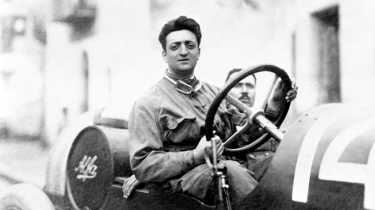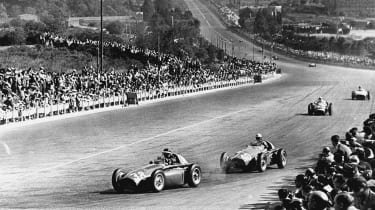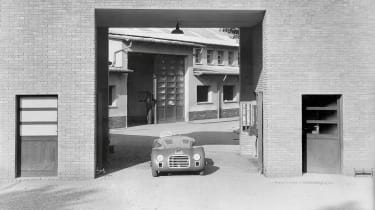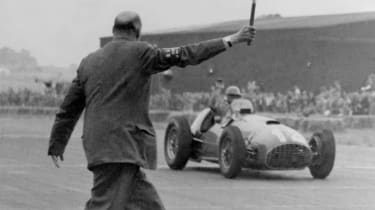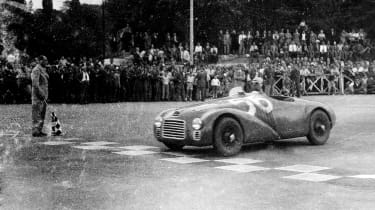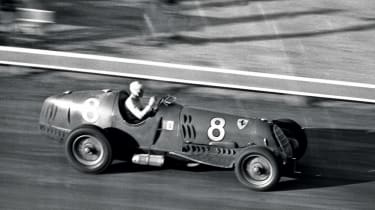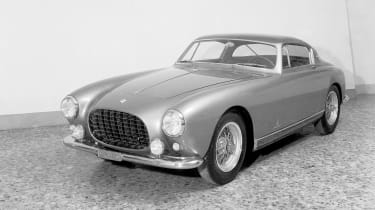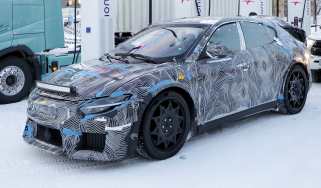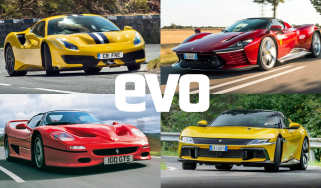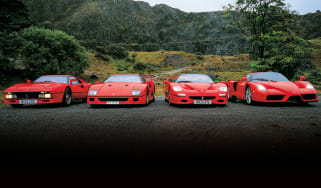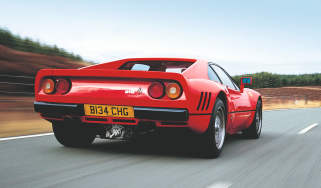Enzo Ferrari: the life of the man who built the brand
We tell the story of Ferrari’s founder, from his rise from racer to team boss to going it alone after severing ties with Alfa Romeo
'Do us a story on Enzo Ferrari,’ they said. Of course, the proposition is quite simple, but how can one adequately address the most significant single motor racing personality of the 20th century in just a few confined magazine pages? The sin will be omission – yet there’s too much to tell to avoid such sin. When the great man died – aged 90 – on August 14, 1988, it was pre-ordained that his passing should be attended by massive media outpourings – obituaries, tributes, potted biographies, the whole effusion of print, film, television and sound tape that today marks the passing of the great and famous.
In essence, Enzo Anselmo Maria Ferrari came from a lower- middle-class Modenese artisan family. He was a common man. He spoke Modenese dialect, blunt and to the point. Yet he was also bright and astute, ambitious and determined – and he had a backbone and determination of spring steel, forged through early adversity, sickness and sense of loss. This was the man who would become an established industrialist and sporting personality of global stature. He became the common man made good who thoroughly enjoyed keeping kings, princesses, dukes, film stars and captains of industry all waiting upon whenever he might judge it convenient to give them an audience at his Modena office or his Maranello factory.
> Ferrari 250 GTO: the history, specs, prices and hype of an automotive icon
The cars his company built were rarefied and exotic. They were especially exclusive. The more wealthy or celebrated the client might be, the more Mr Ferrari played the role of having to be persuaded to let you buy one. That’s the aura he fashioned for himself. He spent decades perfecting the image and building his Prancing Horse brand, and he applied the genuine prestige he accumulated in spades in both racing and on the road car scene. This artisan-class local-boy-made-great never forgot his roots.
A close acquaintance of his confirmed for me recently how Il Drake – as the Italian press came to call him – had never lost his fascination with manipulating the great and wealthy: ‘He liked to see them dancing to his tune, yet, once they offered enough money, he would sell them anything. He loved always to make the big score. The wealthy might have got what they wanted, and gone away smirking, but first they had left their money with him – Ferrari...’
It was in part this merchant, some say peasant, ability that founded Ferrari’s greatness. But more important, he was the great manipulator, a God-gifted exploiter of others’ talents. For decades he had an almost unerring eye, particularly for an engineer who would contribute to the legend. And before that engineer’s potential had been used up, Mr Ferrari would have others groomed and prepared, poised in the wings to take the vacant place. Once ultimately cast aside, most of those engineers’ greatest days, their greatest potential, would be left behind, artfully trapped by the Ferrari filter.
Enzo Ferrari seemed quintessentially Modenese. His home town of Modena at the foot of the Appenines on the southern edge of the vast Po Valley floor has been famed over centuries for its craftsmen. Metal workers, foundry skills, pattern- and tool-making, design ability, sheer creativity, all abound. For decades most of them were willing to work absurdly long hours for laughably low wages. Pride in creation and achievement was taken for granted as a local Emilian tradition; time off and pay-rates came a very distant second. That was just fine for Enzo Ferrari, who developed into one of industrial and commercial history’s greatest manipulators of men.
His father, Alfredo, ran a modest metal fabricating business in Modena, and had two sons – Alfredo, born 1896, and Enzo, born February 18, 1898. Enzo was ten when father took the boys to Bologna to watch the Coppa Florio road race. Felice Nazzaro won in a 130hp chain-drive Fiat. The following year, Enzo watched the local sprint meeting on the Navicello Straight. Motor cars and motor racing excited him greatly.
When Italian-American Ralph de Palma won the 1915 Indy 500, Enzo saw his photograph splashed in the sporting press and made his decision: ‘I’m going to be a racing driver!’ His formal education was relatively sketchy, but his teenage years were spent in self-education. He was always a voracious reader. He fancied himself as a journalist and at 16 contributed Modena FC football reports to the important Gazzetta dello Sport. From his reading he absorbed vast understanding of his fellow man. In the 1980s, when I asked Ferrari’s long-serving chief engineer Ing Mauro Forghieri what he considered to have been The Old Man’s greatest attribute, he thought long and hard before replying ‘…an understanding of human weakness…’. Any chink in a talented man’s personality or character could and would be ruthlessly exploited to La Ferrari’s advantage.
There was tragedy, too. In 1916, Enzo’s father and older brother ‘Dino’ both died. In 1917 Enzo himself was conscripted into the Italian Army, quickly contracted the killer ’flu that took more lives in 1918 than the War itself, and barely survived, becoming subject to ‘a weak chest’ ever after – a proclivity that, when it suited him, he would brandish unselfconsciously to secure any perceived advantage.
> Ferrari Testarossa review, history and specs: TR generations driven back-to-back
By his own account, Enzo wound up alone in the immediate aftermath of the war, but this conveniently ignores his continuing closeness to his surviving mother, Adalgisa, who provided a continuing anchor for his young life. Rejected by Fiat in Turin, he got a job collecting truck chassis for a dealer named Giovannoni and delivering them to a coachworks in Milan, to be bodied as more in-demand passenger vehicles. Thus he got to know and be known by the motoring men of both great cities. One was Ugo Sivocci, who was a proper test driver for CMN. He fixed Ferrari a full-time job there as a test driver, and on November 23, 1919, Ferrari drove a CMN in Italy’s first post-war sporting event, the Parma-Poggio di Berceto hillclimb. He set fourth FTD in his class, and six weeks later drove his CMN home ninth in the first post-war Italian road race, the Sicilian Targa Florio.
After Sivocci moved to Alfa Romeo, for the May 1920 Parma-Poggio di Berceto hillclimb Ferrari bought himself an old 1914 GP Isotta Fraschini. He drove it into third place, then raced it again at Mugello and in the Consuma ’climb. Sivocci then fixed him a job with Alfa Romeo, where he became both a regular minor-league events team driver and right-hand man to Nicola Romeo’s closest aide, Giorgio Rimini. When Alfa Romeo ran stripped production cars in the 1920 Targa Florio, Enzo Ferrari drove one home in second place. Over the next three years he would drive only for Alfa Romeo save for one outing in a Steyr (of all things) on the Aosta-Gran San Bernardo mountain-climb, in 1922. During this period, Ferrari became Rimini’s Mr Fixit.
At the time, Fiat ruled the GP world, its Torinese experimental shop the cutting edge of automotive technology. When Sivocci was killed in the prototype Alfa Romeo GPR (or `P1’) Grand Prix car during Italian GP practice at Monza, Rimini persuaded Nicola Romeo that they should head-hunt Fiat’s design team. Ferrari was Alfa’s chosen envoy, and through him the legendary engineer Vittorio Jano – among others – was attracted from Fiat to Alfa Romeo to found Portello’s glory years.
Meanwhile, Mr Ferrari raced mostly second-string cars. He still notched his first outright win at Savio, Ravenna, in June, 1923, where he claimed his dash and daring won him the Cavallino Rampante – Prancing Horse – emblem of WW1 fighter ace Francesco Baracca from the fallen hero’s family. Into 1924, he won three big races in a row, at Savio, Polesine and Pescara. The latter success earned him a minor honour, that of Cavaliere dell ’Ordine della Corona d’Italia. He was later elevated to Commendatore, which title was used popularly for decades even though he himself explained it was a Fascist honour that was abrogated after the regime’s 1943-45 defeat. He himself preferred to be called ‘Ingegnere’, or ‘Mr’ or ‘just plain Ferrari’.
Meantime, his 1924 hat-trick of race wins persuaded the Alfa management to nominate him as fourth driver for their Grand Prix team of new Jano-designed `P2’ cars entered for the biggest race of the year – the Grand Prix de l’ACF at Lyon-Givors.
Mr Ferrari practised there, but opted out pre-race, fleeing home to Modena. He later explained he’d suffered ‘a nervous breakdown’. The great contemporary Italian journalist Giovanni Canestrini reputedly believed privately ‘...he was just plain scared. The P2 was beyond him.’ It says much for Mr Ferrari’s popularity that not a word of this was published, and that Alfa Romeo stood soundly by him.
Within weeks of Lyons, he was working as closely as ever within the team, but not as a driver... He didn’t race again until 1927, by which time he was running a healthy Alfa distributorship in Modena. He won again at relative bush-league level. By then he had married quite a wealthy Milanese girl, Laura, who travelled everywhere with him to the races.
> Ferrari Dinos go head-to-head – 246 GT v 206 GT
As a dealer, Mr Ferrari’s Modena premises attracted a wealthy clientele of gentleman racers, and at the end of 1929 he persuaded three of them, the Caniato brothers and Mario Tadini, to finance the foundation of the cooperative Scuderia Ferrari to prepare, enter and run their sporting Alfa cars. They could then just report at the right place on the right day and find their cars present, ready to race; entries, everything, organised by Ferrari.
Enzo’s own last victory as a driver came in the Bobbio-Passo del Penice mountain climb on June 14, 1931, while his very last drive came in the Tre Provincie road race on August 9 that year, in which he battled long and hard against Tazio Nuvolari and was only narrowly beaten into second place.
At his best, Mr Ferrari had been a cool, analytical and cultured racing driver. Certainly during the 1940s and ’50s his own engineers would quite highly rate his test-driving abilities and the useful feedback gained. Behind the wheel of a road car, he was quick, safe and neat, almost to the end of his driving days. Meanwhile, in 1931, ever the accomplished publicist, Mr Ferrari made much of the reasons for his retirement from racing and the loss it meant to him. He had always promised Laura he would retire from driving when they had children. She had just told him she was pregnant.
Their son was born on January 19, 1932. Respecting family tradition they named him Alfredo, after both Enzo’s Papa and elder brother Alfredo. The affectionate diminutive of Alfredo is ‘Alfredino’, hence Dino Ferrari, the Old Man’s ill-fated son.
Alfa Romeo’s own factory team ceased activities due to financial straits in 1932. Mr Ferrari thereafter manoeuvred his Scuderia into quasi-works team duties. From mid-1932 until 1937, the Scuderia became ‘Alfa Romeo Racing’. Mr Ferrari’s journalistic ambitions found an outlet in a string of Scuderia publications, a magazine and a newspaper. Part of his policy was to publish glowing profiles of race organisers with whom he dealt. This fostered close relationships from which the Scuderia undoubtedly profited...
But this happy time was stopped in its tracks by the 1934 emergence of State-backed German racing teams from Mercedes-Benz and Auto Union, which quickly dominated GP racing – scooping all the top prize and bonus money. Unable to match the TransAlpini, as he called them, in money, men and metallurgy, Ferrari looked to earn elsewhere. In 1935 two twin-engined Alfa Romeo Bimotore Libre cars were built in his Modena premises, but their success was limited. Nuvolari scored a shock win in a Scuderia Alfa at the 1935 German GP, but it was a one-off. In 1937 Mr Ferrari master-minded the creation of a 1.5-litre supercharger Vetturetta class challenger – the Formula 2 of the day – and this emerged from his Modena works as the Alfa Romeo 158 Alfetta. But Alfa’s new president, Ugo Gobbato, promptly took his company’s racing programme back in-house for 1938, the Scuderia in Modena was wound up and Mr Ferrari could stomach only briefly being Direttore Sportivo under more senior management’s eye in the new Alfa Corse HQ at Milan. With his style emphatically cramped, he walked out late in 1938.
One clause of his severance agreement was that he would neither build nor race cars under his own name for four years. Short-term he set up a top-quality precision machine-shop business in his old Scuderia HQ on Modena’s Viale Trento-Trieste under the title Auto-Avio Costruzioni. It was there that the son of his 1924 Alfa Romeo team leader, Antonio Ascari, called on him, around Christmas 1939.
Young Alberto Ascari and his aristocratic friend, the Marchese Lotario Rangoni, wanted Ferrari to build them sports cars capable of competing in the 1500cc class of the forthcoming short-circuit Mille Miglia at Brescia in 1940. Fiat was offering attractive bonuses for Mille Miglia success with cars based upon its components, so AAC produced two otherwise anonymous ‘815’ cars powered by Fiat-derived 1500cc straight-eight engines. At Brescia, young Ascari and Rangoni ran quite well before retiring. But then came the Second World War and Ferrari moved his company into the Appenine foothills at Maranello, manufacturing German-designed machine tools.
During the hostilities, Ferrari performed a balancing trick of immense (and perilous) diplomacy between Mussolini’s Fascists and communist pro-Allied partisans (especially prevalent and active around Modena). Now, as war ended, he was already teeing-up production of new road and racing cars, by this time free of Alfa severance clauses, and able to deploy his own name.
Meanwhile, engineer Gioacchino Colombo – prime designer of the 158 Alfetta – was at a loose end, laid-off by Alfa and reputedly shunned for too-enthusiastic support of deposed and dead Mussolini. Such loyalty to a dictator was just fine by Mr Ferrari…Colombo, he decided, was the man for him. And so Ferrari made his proposal for a post-war high-performance sports car even with his country ruined by warfare, with smoking craters everywhere. They agreed about the performance and long-term development potential of a V12 engine, and the long line of Ferrari dodici cilindri power units was founded there and then.
Through 1946, Ferrari’s men developed their first V12s, which first emerged in Italian national races in 1947 – seventy years ago – and achieved their first international race win with Raymond Sommer driving a cycle-fendered 159 V12 at Turin that September. Soon, too, Ferrari and the mighty round-Italy Mille Miglia would become forever linked. The Prancing Horse cars would win the event no fewer than eight times between 1948 and 1957. It wasn’t long, either, before Ferrari entered the Grand Prix arena. When Alfa Romeo took a sabbatical from racing in 1949, the Colombo-designed supercharged V12 Ferrari GP cars of Alberto Ascari and Luigi Villoresi began winning world-class races.
Having used up the butterfly-minded Colombo’s original genius, and that of development engineer Giuseppe Busso to make the designs raceworthy, Ferrari now fostered the unsupercharged V12 and four-cylinder theories of replacement engineer Aurelio Lampredi. A tough and ambitious designer, Lampredi did brilliantly by Ferrari. His unsupercharged 4.5-litre V12 GP cars ultimately smashed Alfetta post-war domination in 1951. ‘I feel I have killed my own mother,’ wrote Ferrari, no doubt conscious of his words’ theatricality, yet equally doubtless delighted to have done so.
Lampredi’s unblown four-cylinder 2-litre cars then carried Ascari to motor racing history’s first back-to-back Drivers’ World Championship titles in 1952 and ’53. Sports car successes and sales raged ahead. Mr Ferrari was on top of the motor racing world, bestriding it like a Modenese colossus. It took men of equal stature, and hardness, to cut him down. One such was Tony Vandervell, who made the Thinwall bearings that had solved the early Ferraris’ greatest frailty. Between him and Mr Ferrari it was a classic case of flint cut flint.
But Lampredi’s sun soon set. When he failed to deliver the goods in 1955 he was unceremoniously ejected (to Fiat) and, largely by good fortune, Lancia hardware and that company’s ex-Alfa engineer, Vittorio Jano, landed instead in Ferrari’s lap.
On the road car front, Ferrari had established a proper production division in consort with yet another hard man of the Italian industry, stylist and coachbuilder Battista ‘Pinin’ Farina, to build and sell GT cars on the success of his racing team. Sports-racing victories at Le Mans and in myriad other long-distance races proved their cars. Above all, the greatest Ferrari characteristic was ‘unburstability’: engines and drivelines that simply ran and ran, gearchanges that loved being used. Horsepower was everything, handling secondary. Engines to the fore, chassis mere brackets to prevent the wheels falling off.
Such attitudes did not always make for ‘easy’ racing cars. Many drivers died in Ferrari cars, most doing something they absolutely loved in cars that – despite their controllability issues – they often utterly adored. When works team drivers like Musso and de Portago were killed racing, Ferrari was pilloried; he grieved publicly, but continued racing undeterred. He’d simply seen it all before… and his empire grew and grew.
> Ferrari 308 GTB/GTS: history, specs and buying guide
Following son Dino’s death in 1956 at the age of 24 – from muscular dystrophy – the Old Man publicly agonised over his company’s destiny, deprived as he was (he said) of an heir. His very public and Latin grievings – and writings – are almost embarrassing for the Anglo-Saxon mind to share, no doubt fuelled by his bereaved wife Laura, Dino’s death simply driving her to distraction. Then, in the mid-1960s the public grievings abruptly fell quiet. Piero Lardi, the son of Mr Ferrari’s mistress, Lina, and born at the end of the war, was working at Maranello. Reputedly Laura would occasionally try to track him down there, making the poor boy run for cover. Ultimately, on Laura’s death, Mr Ferrari publicly acknowledged Piero – tangible consolation; in many ways perhaps Piero’s unenviable legacy…
Still, as Phil Hill once put it, Mr Ferrari was always busily stoking the fire under the boiling cauldron into which every racing driver worth his salt would only too willingly jump. The bad times of 1955, when his GP and sports cars alike were beaten out of sight by re-emergent Mercedes-Benz, ended when with Fiat support he fell heir to the Lancia hardware and technology upon the Turin company’s collapse.
This kept the wolf from Ferrari’s door in both financial and mechanical terms from 1956 to 1961. Come 1962-63 and he was feeling the chill again – and was courted assiduously by Ford Detroit. Skilfully, Ferrari used the naïve advances to wind up Fiat and send the Americans packing. Better funded, he was then able to deny Ford the rich promotional prize they most coveted – victory in the Le Mans 24-hour race – through 1964-65. But the US giant sought revenge and (eventually) achieved it by smashing Ferrari at Le Mans between 1966 and 68.
By 1969 everything was going wrong. Ferrari was making too few production cars to maintain adequate profitability. Formula 1 fortunes were slithering down the tubes. The V12 replacement flat-12 engine design was teething badly. Ferrari approached Gianni Agnelli at Fiat and the younger Italian magnate agreed to Fiat purchasing half of Ferrari’s company stock at a fixed annual rate, to be paid as long as the vendor should live… an Italian legal form known as in vitalizio. Mr Ferrari was doubtless determined that the purchase would cost Fiat dear…
Thereafter Fiat was careful not to be perceived to be meddling; the opprobrium of interfering with the Formula 1 Grand Prix programme, Mr Ferrari’s great love – his first love, for which he built road cars simply to fund competition – always threatened within Italy ‘more public aggravation than it was worth’. As late as the winter of 1987, Mr Ferrari would chair a meeting at Maranello ‘and, no question, only one man was doing the talking’, as one engineer present would tell me.
With the facilities, experience and the technological back-up within Fiat, there was little good excuse (at least until Honda, BMW and Renault entered the Formula 1 fray) for Ferrari not to dominate racing for years on end. But, repeatedly, internal politics at Ferrari just cost more than it earned, and for many years the reality was that Mr Ferrari repeatedly shot his interests in the foot. After Phil Hill’s World Championship title victory in 1961 and John Surtees’ in 1964, internal feuding would chase the Englishman out of Maranello in 1966, and it would not be until 1975 – and the advent of Luca di Montezemolo and Niki Lauda as joint campaigners – that Ferrari would achieve such heights within Formula 1 again.
Enzo Ferrari was a great man, no question. He was also a difficult man, and a hard man. His liking for politics and plotting often backfired upon him, but consider the workload he sustained in creating his company, the application that saw him juggling in-house engineers and design, combined with outside sub-contract chassis supply, and bodywork supply, and balancing capricious automotive haute couture customer needs, commercial concerns, driver contracts, competitiveness and complaints, manipulation of sporting regulations, future planning, a visit from the King of the Belgians, or some Hollywood film star… Every one of his 16-hour working days was absolutely jam-packed for more than 70 years.
And all this from a man who grew in stature from meagre Modenese roots into the giant, Il Drake as they called him, ‘The Dragon’. For me, one recollection of his long-time secretary through the 1950s – Romolo Tavoni – explains so much about the commitment, the intensity, the ambition of the man. In Modenese dialect he could often be ruggedly blunt, as he was on this occasion around 1953-54. ‘You know…’ he observed, with a sigh, ‘it will only take three bank managers in Modena all to talk to one another, and we’re f---ed!’ Bravo, Ferrari.
Doug Nye
This feature was first published in Enzo issue 1 & 2.
